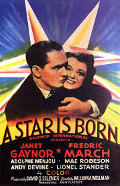
Directed by
William A Wellman
111 minutes
Rated PG
Reviewed by
Bernard Hemingway

Star Is Born, A (1937)
Janet Gaynor and Fredric March star in the original version of the film which was the basis for the better-known 1954 George Cukor remake
In its day William Wellman's film was an A-list picture, shot in Technicolor (by W. Howard Greene who won an honorary Oscar for his work) with a bunch of top writers (including Dorothy Parker) buffing up an original story (that also won an Oscar despite being a "re-working" of Cukor’s 1932 film What Price Hollywood?) by Wellman and Robert Carson with Max Steiner providing the score and producer David O. Selznick keeping a tight rein on proceedings.
Today the film looks a little dated with Gaynor whose roots were in the silent era (she had starred in F.W. Murnau's 1927 silent classic, Sunrise) and who was popular in her day for her wholesome ordinariness somewhat hard to accept as an overnight Hollywood sensation although this is due more to the director and his writers not finding a way to effectively dramatize the rise of her Vicki Lester and the simultaneous fall of March’s Norman Maine. It is impossible to really see why the one or the other occurs but as the fulfillment of the plot’s moral purpose. The film's tone is also uneven, treading an unsteady path between tragedy and comedy notably in the character of Lionel Stander's press agent who, as was for the time so commonly the case with such a role, seems initially intended to provide comic relief but who turns out to be remarkably nasty.
Still, the film was a critical and box office success in its day offering a neat fable of the perils of celebrity culture that despite being presented with old-fashioned sentimentality we can still appreciate. Perhaps the most interesting aspect of the film however is its self-awareness announced by a framing device which acknowledges that the film is itself a construct that belong to the self-same illusory world of which Vicki and Norman are a part.
Want something different?





